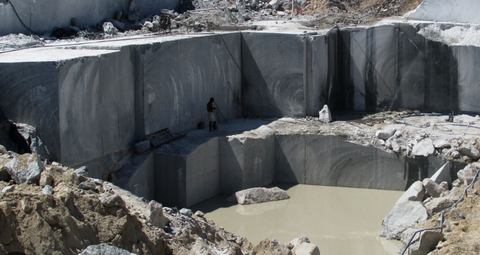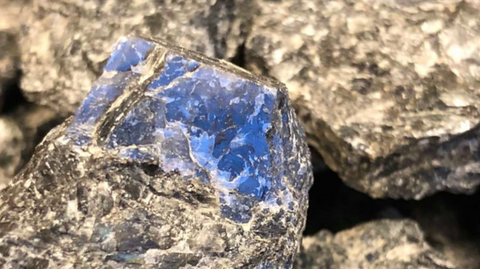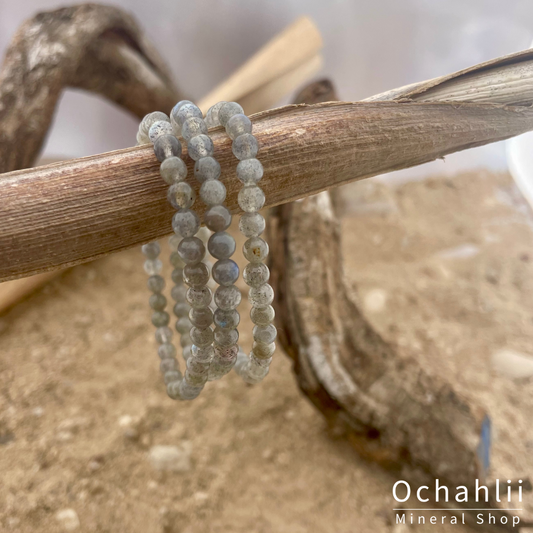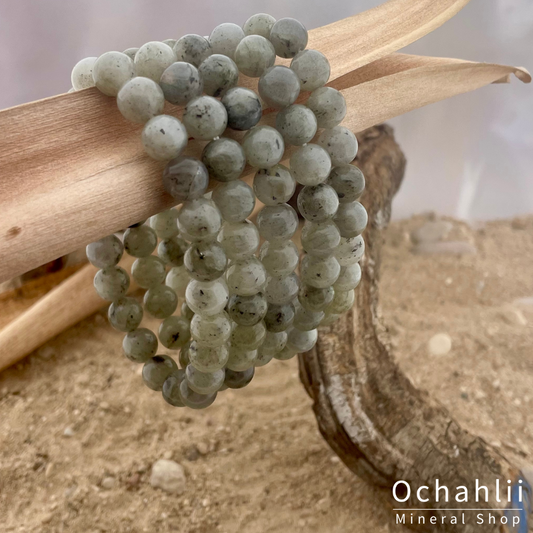
Labradorite and spectrolite.
Share
"Labradorescence Unlocked: Labradorite's Story from Crystal Structure to Spiritual Meaning"
Labradorite is a fascinating gemstone known for its unique optical property known as labradorescence. This property creates brilliant colors that change when the stone is viewed from different angles. Labradorite belongs to the feldspar family and is named after the Labrador Peninsula in Canada, where it was first discovered. This blog post delves into the world of labradorite, exploring its properties, history, spiritual significance and practical applications.
Properties and Characteristics
Labradorite has a hardness of 6 to 6.5 on the Mohs scale, making it quite durable for jewelry. The color spectrum of this stone includes blue, green, yellow, orange, and sometimes even purple. This pop of color, combined with its intriguing labradorescence, makes labradorite a popular choice for jewelry makers and collectors. 
History and Origin
Although labradorite was first officially identified in Labrador, Canada, in the late 18th century, it was used by indigenous peoples much earlier. It is said that the Inuit tribes believed that the stone captured the Northern Lights. Since then, labradorite has been found in other parts of the world, including Finland, Russia, Australia and Madagascar.

Labrador in Canada
Magma-related formation
- Crystallization from magma : Labradorite forms when magma slowly cools and crystallizes. It is a plagioclase feldspar, meaning it belongs to a group of minerals that typically form in mafic (rich in magnesium and iron) to intermediate magmatic rocks such as basalt and gabbro. During the cooling process, the minerals that form can vary depending on the chemical composition of the magma and the cooling rate. Labradorite crystallizes at temperatures slightly lower than those required for the formation of other feldspars, allowing it to develop unique structures and properties, such as the characteristic labradorescence.
- Differentiation of magma : In some cases, labradorite can form through the process of magma differentiation, where the magma separates into different chemical layers. This can lead to the concentration of specific minerals, including labradorite, in certain parts of the magma, resulting in rocks with high levels of this mineral.
Metamorphic formation
Labradorite can also be formed by metamorphism, the process in which existing rocks are transformed by high temperatures and pressure, without the rock melting. This can happen in different geological settings, such as:
- Contact metamorphism : When magma intrudes into surrounding rock, the intense heat of the magma can metamorphose the surrounding rock. In some cases this can lead to the formation of labradorite within the metamorphosed rocks.
- Regional metamorphism : This takes place over large areas under the influence of high pressure and temperature associated with mountain building. Although labradorite is less commonly associated with regional metamorphism than with magmatic processes, it can still occur in certain metamorphic rocks formed under the right conditions.
Labradorescence
Labradorite's unique optical property, labradorescence, is a result of the mineral's internal structure. This structure consists of thin, parallel lamellae or layers within the crystal. When light penetrates these layers, it is reflected and scattered, creating the striking shades of color that are visible from different angles. This property is not directly related to the mineral's mode of formation, but rather is a result of the internal structure developed during crystallization.
Locations
- Canada : Labrador, the namesake of labradorite, is one of the original and best-known sites. The stones from this area are known for their strong labradorescence and broad color spectrum.
- Madagascar : : Labradorite in Madagascar is mainly found in the southern part of the island. The main extraction areas are in the regions around the town of Toliara (also known as Toliary or Tulear) and in the Anosy region, closer to Fort Dauphin (also known as Taolagnaro). These areas are known for their rich mineral deposits including high quality labradorite which is known for its exceptional labradorescence and wide range of colours. The labradorite mined in Madagascar is popular for its aesthetic appeal and is often used in jewelry and as a decorative material. Madagascan Labradorite can range from deep blue and green to golden and even purple hues, making it a sought-after variety for gemstone collectors and jewelry designers alike. Due to the high quality of the labradorite found there, Madagascar plays an important role in the international trade of this special gemstone.

Labradorite mine in Madeagascar
- Finland: The first and most famous Spectrolite site in Finland is Ylämaa, located in the southeast of the country, close to the Russian border. This region became world famous when Spectrolite was discovered there after the Second World War. The conditions under which Spectrolite formed in this region have been particularly favorable to the development of its unique color spectrum and intensity of labradorescence. The area around Ylämaa remains the primary source of Spectrolite, and the stone is often associated with this specific location in Finland. The main difference between Labradorite and Spectrolite lies in the quality of the Labradorescence. Spectrolite has a broad and intense color spectrum that is often considered superior to that of labradorite from other locations. Color and Intensity: While Labradorite can exhibit an impressive range of colors, Spectrolite is known for its exceptional clarity and the intensity of its colors. Spectrolite can exhibit all colors of the spectrum, often in a single stone, making it a particularly sought-after variant.
- Location : Spectrolite is unique to Finland, which means that stones with this name only come from this country. Other labradorites, although similar in chemical composition, do not always achieve the spectacular richness of color that characterizes Spectrolite.

Spectrorite in raw form
Prehistoric and Indigenous Customs
Although the first official discovery of labradorite dates back to the late 18th century in Labrador, Canada, indigenous peoples in Canada and the Inuit culture are known to have used the stone much earlier. They valued labradorite for its aesthetic beauty and spiritual significance. According to tradition, the Inuit believed that labradorite contained the frozen fire of the Northern Lights, and they used the stone in ceremonial applications and as a talisman to protect against negative energy.
European Discovery and Use
After its official discovery in the 18th century, labradorite began a journey across the Atlantic Ocean to Europe, where it quickly became popular among gemstone collectors and jewelers. Its unique beauty and changing colors made it a sought-after object in the jewelry industry, and it was used in a variety of decorative objects and jewelry.
Spiritual :
Labradorite is known for its protective properties, warding off negative energies and protecting the wearer's aura. It promotes transformation and personal growth, helping individuals navigate periods of transition. This crystal increases intuitive abilities, which contributes to spiritual growth and the opening of the third eye. It has a calming effect on the mind, reducing stress and anxiety, making it ideal for meditation. Labradorite stimulates creativity and imagination, and supports the generation of new ideas. It facilitates communication with the higher self and spirit guides.
Labradorite is widely used by therapists to protect themselves energetically.
Practical applications
Beyond its spiritual significance, Labradorite is also used in various practical applications. Due to its unique beauty, it is widely used in jewelry such as pendants, rings, bracelets and earrings. In addition, labradorite is also valued in interior decoration, such as counter tops, and as a collectible by mineral enthusiasts.

Care and Maintenance
To keep labradorite in optimal condition, it is important to treat the stone carefully. It must be protected from sharp impacts and scratches. Before cleaning, it is recommended to wipe the stone gently with a damp cloth and avoid coming into contact with harsh chemicals.
Conclusion
Labradorite is more than just a beautiful stone; it carries a rich history, spiritual significance and versatile applications. Whether you are drawn to its aesthetic appeal or its mystical properties, Labradorite offers something for everyone. It remains one of the most intriguing gemstones in the world of gemstones and minerals.
You can find our offer HERE




